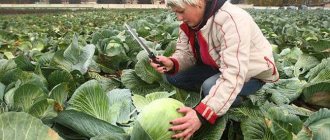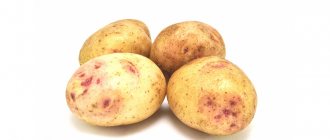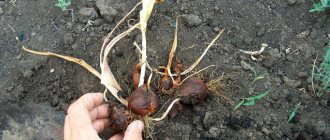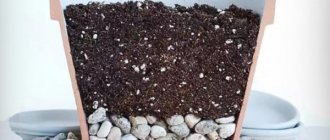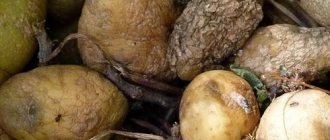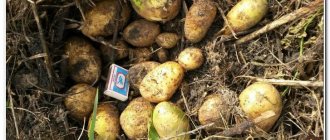Vegetable growing » Potatoes
0
2300
Article rating
Kira Stoletova
It is important not only to grow potatoes correctly, but also to preserve them. In this article we will tell you how to store potatoes in the cellar and how to preserve a high-quality harvest before the onset of warm weather.
Rules for storing potatoes in the cellar in winter
The best varieties of potatoes for winter storage
Potato varieties of mid-late and late ripening are best suited for winter storage - the duration of the dormant period approximately corresponds to the length of the growing season.
For harvesting root crops for the winter, it is important that the late varieties are the most delicious, have a high starch content and are rich in beneficial microelements.
The most popular potato varieties for winter storage (Middle zone and Moscow region)
| Variety and ripening period | Description of the variety | Descriptions of root vegetables |
| Picasso (late) | A productive variety of Dutch selection for the Moscow region and southern regions (up to 20 tubers in a nest), drought- and heat-resistant, rarely gets sick. | Oval beige root vegetables (from 100 g) with pink eyes. The pulp is creamy. |
| Zhuravinka (late) | An unpretentious variety of Belarusian selection, resistant to most potato diseases, including scab and late blight | Smooth tubers (from 100 g) with a red skin, the flesh when cut is yellow. |
| Asterix (late) | The Dutch selection variety is characterized by increased resistance to mechanical damage and long-term storage | Smooth root vegetables (about 100 g) with red skin and yellow flesh. |
| Lorch (mid-late) | A high-yielding variety with increased keeping quality of tubers, it is not afraid of late blight and cancer. | Large root vegetables (100-120 g) beige in color with white pulp. |
| Blueness (average) | An unusually productive (up to 500 kg per 1 acre) large-fruited variety, resistant to viruses and fungal diseases. | Large (from 150 g) smooth tubers of excellent taste, white in color with white pulp. |
How to prepare tubers for storage in the cellar
It is not recommended to remove tubers directly from the field to the cellar - it is impossible to do without special preparation of root crops. All subsequent activities after digging potatoes have one goal - to quickly transfer the tubers to a state of rest, when metabolic processes are reduced to a minimum.
- After harvesting from the garden, root crops must be dried. In clear weather, this can be done directly in the garden bed, 2-3 hours is enough. In practice, potatoes are most often dried in a closed shed for 1-2 days. This time is enough for all the dirt to dry and fall off.
- After drying, the tubers are quarantined before being stored in the cellar: potatoes in bags or in bulk, without access to light, are kept for 2-4 weeks at a temperature of 15-17°C. During this period, hidden diseases and rot of tubers usually appear.
- After the quarantine period, the potatoes are carefully sorted, removing all diseased and damaged tubers.
The potatoes are ready to be stored in the cellar.
Necessary and correct conditions for storing root vegetables
To preserve the crop for a long time, certain conditions must be met.
- For potatoes, a temperature range of 3-5 °C is of great importance. At a higher temperature, the tubers will begin to germinate, at a lower temperature they will freeze and become unsuitable for consumption.
- The room should be dark to protect the tubers from the formation of solanine.
- A state of rest does not mean a suspension of metabolic processes - the tubers breathe and release moisture. To successfully store potatoes, good ventilation in the cellar is necessary. Humid air and drops of condensation provoke the development of rot.
- It is necessary to caulk all cracks in advance and take care of protection from rodents.
- It is best to sprinkle the floor in the cellar with sand - it partially absorbs excess moisture. Linoleum, cement, slate are unacceptable materials for covering the floor in the cellar, as they lead to the accumulation of moisture and promote the development of fungi.
Common Mistakes
Improper handling of vegetables and violation of the rules for storing them worsens the taste of the vegetable and generally makes it unsuitable.
The most common errors associated with crop storage include the following:
- Storing damaged potatoes. A vegetable infected with pathogenic microorganisms is a source of infection of healthy tubers. This causes massive rotting. In this case, it is not possible to save the crop.
- Reluctance to sort through potatoes from time to time. Vegetables need to be sorted at regular intervals in order to promptly remove specimens affected by pathogenic microflora.
- Storing all types of potatoes together. It is necessary to sort out early, mid-season and late species.
- Poor drying of potatoes. After the harvest is harvested, it must be thoroughly dried, otherwise massive damage to the tubers by bacterial ring rot may occur.
- Lack of ventilation in the room. Under such conditions, the tubers quickly rot.
- Insufficient disinfection of the premises. Before moving vegetables into the storage room, be sure to treat the walls with whitewash material.
- Using tight containers. If too many potatoes are placed in a box or bag, individual tubers will experience strong pressure from neighboring ones and shrink. This leads to the formation of gray spotting.
This video talks about sorting potatoes, choosing the right container and place to store them:
To preserve potatoes from harvest until spring, you need to prepare both the place where they will be stored and the tubers themselves. Vegetables should be kept in optimal conditions of temperature and humidity, not subject to mechanical pressure, and inspected from time to time for rotting and other diseases.
0
0
Copy link
Containers for potatoes - pros and cons
Depending on the size of the cellar, its arrangement, and the amount of harvest, various methods of placing potatoes in the cellar are used in practice.
Bulk storage
The easiest way is to place the tubers in a continuous layer in the cellar. Even with a significant cellar size, the height of the tuber embankment should not exceed 2 m. This requirement has a clear explanation.
- During storage, the tubers evaporate water. Bulk storage does not provide sufficient ventilation to the lower layers of potatoes. As a result, rot develops, which affects the entire mass of tubers.
- When stored in a mound that is too high, the lower layers of tubers are compressed and dark spots appear, which spoils the presentation.
Storage in bulk complicates monitoring the safety of tubers - rotten ones are not visible in the total mass.
The only way out is to periodically go through the entire mound and discard unusable potatoes.
In boxes
It is much more convenient to store tubers in boxes or containers. This method of storing crops has a number of advantages.
- Air circulates freely between the boxes in the cellar, which improves the preservation of tubers.
- The boxes can be installed to the entire height of the cellar.
- When stored in rigid containers, tubers do not receive mechanical damage, which significantly reduces storage losses.
- It is much more convenient to control the safety of tubers that are stored in mesh boxes.
- The boxes are convenient to use for storing various varieties of tubers.
The boxes come in wood and plastic, each holding approximately 10 kg of potatoes.
To store the tuber harvest, instead of small boxes, container boxes made of boards or made of metal mesh are often used. The latter effectively protect root crops from rodents.
The only drawback is that containers in large quantities must be purchased in advance and disinfected before planting the tubers.
In bags
A very popular storage method: the container is inexpensive and versatile. The bags are convenient not only because of their availability and low price - they differ in the material of manufacture, strength, size (from 10 to 50 kg of tubers), they are solid and mesh.
From a hygiene point of view, it is preferable to choose mesh bags for storing tubers; it is easy to control the condition of the potatoes in them. Tubers in bags also cannot be stored up to the ceiling; fabric or mesh does not protect against mechanical damage.
Some recommendations on how best to preserve potatoes until spring can be found in the video.
Potatoes in boxes
Methods for storing potatoes in boxes
The arrangement in the compartments provides for the storage of potatoes in boxes, in nets and in bags:
- The boxes should have 2-4 cm gaps between the slats for intensive ventilation.
- The distance from the floor to the bottom of the box is about 20 cm.
- The distance between the wall and the box is at least 30 cm.
- The space between the drawers is from 10 cm.
- The distance between the ceiling and the potatoes in the top drawer is at least 60 cm.
The advantage of this type of potato storage is the ability to build boxes with your own hands according to individual sizes, divide them into sections, which will allow you to sort the potatoes by purpose and variety.
Preparing the cellar
Before storing root crops for the winter, the cellar must be prepared - get rid of insect pests, fungal spores and rot. About a month before harvesting, the cellar is disinfected.
- Brick walls and ceilings are whitened with a lime solution (2.5 kg per 1 bucket of water) with the addition of 50 g of copper sulfate. Vitriol can be replaced with factory-produced anti-mold preparations.
- Wooden surfaces (partitions, shelves, drawers) are treated with a spray bottle with a saturated solution of pharmaceutical potassium permanganate or vitriol (100-150 g per 1 liter of water).
- The earthen floor is sprinkled with fluff lime in a 1 cm layer.
- Use a blowtorch to burn out mold colonies in the corners.
- Seal all cracks and passages of rodents with cement mortar.
- Clean the ventilation duct and cover it with a metal mesh.
- Following the instructions, fumigate with a “Climate” sulfur bomb.
Not earlier than 2 days after treatment, ventilate the cellar well.
And to prevent the cellar from flooding, you need to use high-quality materials, such as Corsis 110 pipes on the website ingplast.ru, with it there will certainly be no leaks.
When can you dig up potatoes?
The surest sign of tuber ripening is drying of the tops. The tubers begin to intensively increase their mass a month before the above-ground part dies off. Withering tops gradually release nutrients to the tubers. That is, as soon as the potato bushes turn brown, this means that the tubers have reached their physiological maturity and will no longer grow, and the content of starch and dry matter in them has reached its maximum. The time to dig potatoes in each region depends on climatic and weather conditions: in one area, harvesting begins in July or August, and in another - only in September. If in doubt, dig up a couple of bushes and determine how ripe the tubers are.
How to preserve seed tubers in a cellar
It is not for nothing that summer residents pay special attention to the storage conditions of potato planting material - the entire harvest of next year depends on this. To preserve the germination of seed tubers, certain conditions must be maintained in the cellar and the following rules must be followed:
- constant temperature in the range of 2-4°C;
- a competent ventilation system that removes excess moisture;
- lattice boxes are used to store planting material;
- the gap between the drawers is at least 10 cm;
- do not fill the boxes to the top to make it easier to control the condition of the tubers;
- During the winter, seed tubers must be sorted at least 1-2 times;
- sprouts on tubers should be cut off, not broken off, so as not to damage the reserve growth buds of the eye;
- To protect against fungi and rot, it is useful to layer the tubers with layers of wormwood, mint, honey, and rowan leaves.
Excess moisture that evaporates from potatoes is well absorbed by radishes and beets. They are poured in one layer on top of the tubers; radish phytoncides have an additional disinfecting effect.
Why potatoes are poorly stored: main mistakes
It often happens that you seem to have harvested the crop on time and correctly, prepared it and put it in the cellar or on the balcony for storage, but for some reason part of the crop has spoiled.
To prevent this from happening next time, we suggest that you familiarize yourself with possible errors in advance. At least this way you won't have to learn the hard way by losing part of your harvest.
So, the most common mistakes and blunders that can be made in the process of storing potatoes for winter storage:
Wrong variety (early ripening)
Not all varieties are suitable for long-term storage. Early varieties are intended exclusively for consumption as food or for a short stay in the cellar (1-2 months). No matter what conditions you create, early ripening potatoes will still begin to germinate, and at the same time lose their taste.
Thus, for storage you should choose only late and mid-late varieties, maximum mid-ripening. Extra-early, early and mid-early - for consumption only.
Poor quality tubers (damaged and diseased)
When storing potatoes, you should be very careful about the process of sorting and calibrating them. A few diseased tubers are enough to infect the entire crop. It must be remembered that only healthy potatoes can last the whole winter.
Important! Tubers with minor damage (any slight scratches or cuts received during digging and sorting) should be stored (albeit for a short time, they need to be consumed first), but they should be kept apart, separate from the whole ones.
Storing with other vegetables and fruits
Often, in order to save space in storage, inexperienced vegetable growers put all vegetables in one box, but in the case of potatoes, this should not be done.
You can and even need to store potatoes only with beets , which should be placed on top of the tubers. This proximity will benefit both vegetables, since the beets will absorb all the excess moisture, thereby protecting the potatoes from rotting.
By the way! Read about ways to store beets for a long time in this article .
Failure to comply with storage conditions
The consequence of violating the requirements for the premises (its temperature, humidity (ventilation) and illumination) will be damage to the crop.
Potatoes started to sprout
Advice! If you have problems with air circulation (the most common problem), try to at least ventilate the room in a timely manner.
If it is easy to comply with these conditions in a cellar or basement, then when storing crops in an apartment, on a balcony or loggia, this will be much more difficult. Therefore, if you decide to store potatoes without a cellar, then you should follow all recommendations for home storage.
Rare preventive examinations of tubers
If you don’t want to come one day and find that half of the potatoes have rotted, then periodically you need to carefully inspect and sort through the tubers, discarding the spoiled ones and those that were lying next to them (perhaps the disease simply has not yet manifested itself on them).
Note! Even though in appearance everything seems to be in order, if the potato has an unpleasant odor (rotten aroma) or small flies (fruit flies) are flying around - these are clear signs that there is a rotting tuber hidden somewhere, and its need to be found and removed from storage as soon as possible.
Video: 5 mistakes when storing potatoes
We hope you now have a clear understanding that sorting and preparing tubers, processing them before storing, as well as maintaining optimal storage conditions for harvested vegetables will help improve the quality of stored potatoes.
Video: how to store potatoes in winter
Useful tips for storing potatoes
To increase the keeping quality of potatoes, experienced summer residents share their experience. Almost all recommendations relate to maintaining constant conditions for temperature and air humidity.
- To prevent the tubers from rotting, it is better to install the boxes at a height of approximately 20 cm from the floor level.
- It is advisable to place bags of sawdust or a layer of beets on top of the root vegetables - excess moisture will be absorbed and will not create unnecessary problems.
- It is better to store different varieties of potatoes in separate containers.
- Arrange a “suspended ceiling” from PE film - condensation from the ceiling will not drip onto the tubers.
- At the end of January, it is necessary to sort out the tubers - the remaining ones are guaranteed to last until spring.
- Elderberry leaves will protect tubers from mice, and wormwood and fern from rot.
Storage Features
There are 3 stages of the storage period of this crop, each of which has its own characteristics:
Post-harvest period
Including a period of treatment and cooling. At this time, the dug up tubers are dried, ripen and damage is healed. After removing the potatoes from the ground, leave them in the beds for a couple of hours. During this time, the tubers are slightly dried. You should not leave them in the open rays of the sun for a long time, as the tubers can get burned. We transfer the vegetable harvest to a shaded and well-ventilated place and lay it in as thin a layer as possible. So we keep the potatoes for several days (up to 2 weeks). During this time, the tubers will acquire additional protective properties and heal damage to the skin and pulp by forming a dry skin on them. The healing process is best carried out at 13-18 degrees. In this case, the air humidity level should be about 90%. When the temperature drops, the wound healing process can last up to 3 weeks.
The process of cooling the tubers also plays an important role. So, while healing the damage, gradually cool the potatoes, bringing the temperature to 2-4 degrees. With such cooling, all physiological and biochemical processes in vegetable tubers are suspended. The ideal is to lower the temperature by 0.5 degrees per day, but since few summer residents can control this process in this way, we can only expect a natural drop in air temperature a couple of weeks after the harvesting period. Healing wounds and timely rejection of tubers affected by diseases and pests will increase the level of crop safety.
The main period is winter
When tubers overwinter in a dormant state. This period lasts until the beginning of spring. At this time, it is especially important to observe the storage regime. Each summer resident must carefully take care of the required temperature and humidity in the storage. The optimal temperature for effective preservation of potatoes is 2-4 degrees. With it, not only do all processes in the tubers slow down, but pathogenic microorganisms also do not multiply. At this temperature, the tuber eyes do not die off and remain healthy.
Maintaining optimal temperature
If the air temperature drops, which often happens in very cold winters, the potatoes may freeze. As a result of the fact that starch is converted into sugar, potatoes acquire a sweetish taste and abnormal consistency. Because of this, it becomes practically unfit for food and quickly rots. To prevent this, vegetables are covered with straw, warm blankets or clothes. At elevated temperatures, pathogenic microorganisms and rot quickly develop. To cool the air in the storage room, vents or vents should be opened regularly. To control the temperature in this room, there must always be an accurate thermometer.
Humidity matters too
The safety of the vegetable harvest largely depends on the correct level of humidity. It should be 85-90%. An increase in this indicator leads to the germination of tubers and their “sweating”, which often ends in the appearance of rot. With low humidity, tubers lose their elasticity (turgor), become sluggish, soft, and flabby. Any violation of the humidity level significantly reduces the shelf life of potatoes, so it must be regularly monitored according to the hygrometer readings. To increase humidity, you can spray water on the walls or hang a piece of damp cloth. You can lower the humidity level by regular ventilation, placing containers filled with quicklime, and covering the potatoes with bags of dry wood shavings.
Only in the dark
It is also necessary to consider the illumination of the storage area. When exposed to light, tubers produce the toxic substance solanine, which makes them unsuitable for use in the Pushcha. This process is indicated by the greening of the tubers. As a rule, this problem does not exist in dark cellars and basements, but when storing potatoes on insulated loggias and balconies, this problem should be prevented in advance. To do this, simply wrap the boxes with vegetables with thick fabric or shade them with plywood.
Spring period
Which comes in February-April. During this time, the tubers come out of dormancy. When signs of their germination appear, it is necessary to reduce the temperature at night and in the morning. This is done by opening vents or windows. During this period, the air temperature should not exceed 1.5-2 degrees. Seed potatoes are transferred to a warm place for germination.


